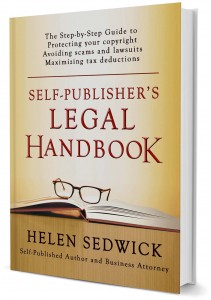File a Fictitious Business Name Statement. Once you have decided on your imprint name, file a Fictitious Business Name Statement (FBN Statement) with the county where your business will be located. Some people will call this a DBA (doing business as) filing. It is a simple and inexpensive task.
An Internet search of Fictitious Business Name and the name of your county will pull up services that handle the recording and publication for a small fee. The cost is typically less than $100. Doing it yourself won’t save much money, so I recommend you hire a company to handle your FBN filing.
Why file an FBN Statement? If you get a check made out to your imprint name, you will have trouble cashing it unless you show your bank a recorded FBN Statement. With an FBN Statement, you may also set up bank accounts and obtain credit cards in the imprint name, which simplifies keeping track of your self-publishing expenses and income.
Consider Trademark Protection. If you are selling your books under an imprint name, that name is your trademark. It identifies the source of the book, the same way the Penguin name and logo would indicate a book was published by Penguin. Your trademark could include an illustration.
If your trademark is not registered with the U.S. Trademark office, then you may mark it with a TM. Only registered marks may use the ® symbol.
Should you register your imprint name as a trademark with the USPTO? It is not required. You will own a common-law trademark as soon as you offer your books for sale under your imprint name.
Federal registration has several advantages. It puts the world on notice of your claim of ownership of the mark. It creates a legal presumption of ownership nationwide, and it gives you the exclusive right to use the mark on or in connection with the goods or services set forth in the registration. The USPTO has various publications to help you.
Trademark protection comes at a cost. Currently, the application fees for U.S. registration are $325 and up. And the USPTO may decide your imprint name does not qualify for trademark registration, and they do not return your fee. You may need a trademark lawyer to assist you, another expense.
Registering your imprint name as a trademark could be overkill.
Let’s pause for a moment and discuss proportionality. Are you paying for a ten-foot cement wall when a picket fence will do?
Think of using the law in two ways. One is defensively. You conduct a trademark search as a defensive measure to avoid infringing on the trademark rights of others. The law is also used offensively (and here I’m using the term to mean to advance strategically, as in football).
If you register your trademark, you will have more options for stopping infringement and collecting damages, in other words, going on the offensive. But consider how much time and money you are willing to spend to stop someone from using a name that infringes on your imprint name. How much are you likely to lose as a result of the infringement compared to the cost of trying to stop it, not only in terms of money, but in time, irritation, and distraction? This question arises with respect to your copyrighted works as well. Most people underestimate the frustrating and consuming nature of litigation.
In other words, you could put off registering your imprint name as a trademark and rely instead on your common law trademark until you see how well your book or books sell.
SHARE THIS





In some areas (such as Milford CT where I live) DBA certificates are handled by the local government, not by the county, and covers the entire state. It cost me less than ten bucks and took about two minutes to fill out the paper. No need to hire anyone to do it.
In some areas (CA?), the DBA intent must be advertised in newspapers.
Is the DBA certificate the same thing as the FBN? Would it be necessary to have both if setting up a very small press?
Diane, A DBA certificate and a FBN Statement are the same thing. You will need to file one if you will be operating as a sole proprietorship under a name other than you own personal name. I cover this in some more detail in the post, https://helensedwick.com/how-to-claim-your-imprint-name/
I went to the local County Office, and they would not allow me to register a name (as in a name that could be a real person’s first and last name) as a DBA. The man at the desk even printed out the law that says I cannot do that. Now what? I do have a name registered (from 20+ years ago) for my publishing company, but what do I do about my pen name and the issue of checks to that name, bank account, etc.
Kathryn, What state are you in so I can check on your local law?
Come up with a list of names, then search to be sure nobody else is using it. Having to change your imprint name is expensive, annoying and causes you tolose the value of any publicity you’ve built up.
1. search online with google and another search engone.
2. search on yahoo
3. search nationwide whitepage directories.
4. search on twitter
5. search on amazon
6. search Books In Print
7. Search Library of Congress catalog
8.in the above searches, search on variations of the name: Penguin Books,Penguin Press, Penguin Publishing, etc.
Keep a record of the above search results (print out pages showing no records found for target name. This willshow good faith and lack of intent.
Doing the above will make you 99% sure nobody else is using the name. There is no way to be 100% sure.
Then stake your claim to your imprint with DBA, a Facebook page, domain name registration.
Great advice. Thank you, Joe.
In CA DBA can also be filed with the county but he newspaper is easier. However if you’re DBA under your name then you don’t have to. These regs are loosey goosey and make no sense. I spent a month investigating it so I could open a business account. Now I’m thinking WTF, I could have kept the account as for 40+ years under only my name and who cared? So I splurged and got my logo on my checks. After all, I have a business.
Digna, If you are doing business under your own name then you don’t need to do a DBA filing.